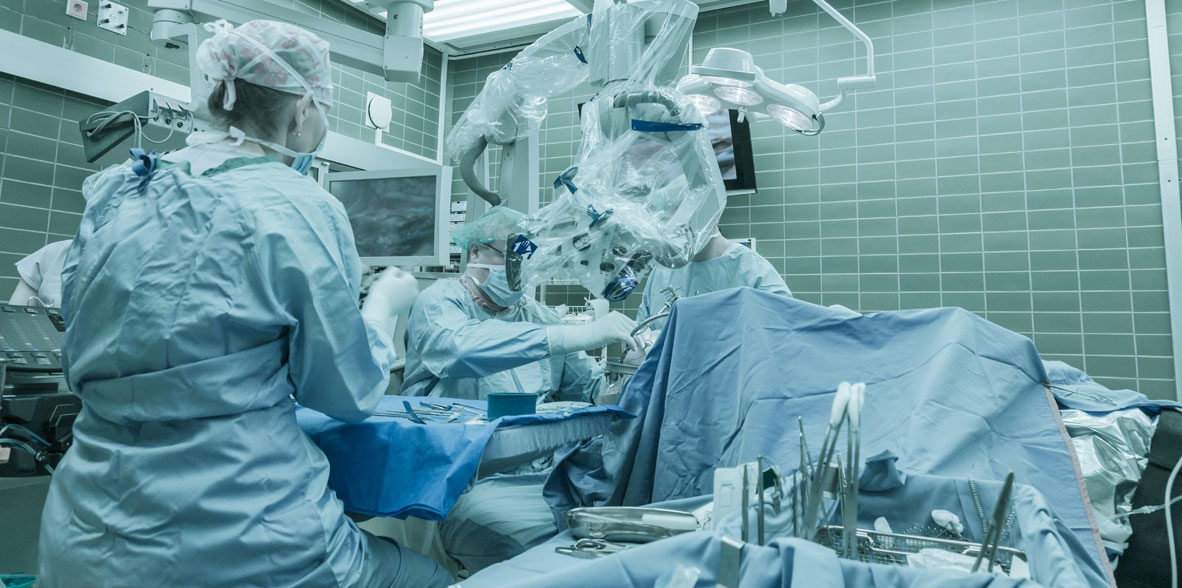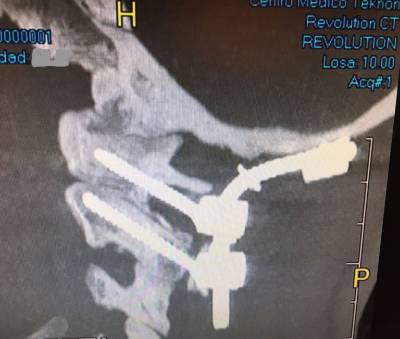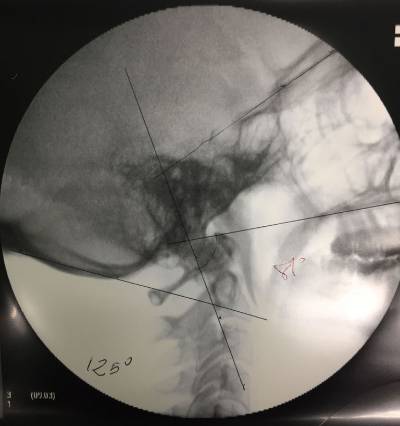

Artrodesis occipitocervical
 Surgical treatment of craniocervical instability usually consists of the posterior fusion of Occipital, Atlas (C1), and Axis (C2). In the Axis, pedicle screws are usually placed, though depending on the patient’s anatomy, screws can be placed in the isthmus. The Atlas screws are generally placed in the lateral masses. In regard to the fixation of the cranium to above mentioned cervical vertebrae, it can be done mainly in two ways. The most frequent and widespread way is the placement of screws in the Occipital bone. Alternatively, the cranium screws may be placed in the occipital condyle. In any of the two ways, the implanted screws are joined by lateral bars which actually are what gives rigidity to the fusion system. In most cases it is convenient to put bone graft, usually autologous, originated from the iliac crest or from the patient’s own rib. In cases where it is not possible to obtain autologous bone graft, heterologous graft (artificial bone) may also be used.
Surgical treatment of craniocervical instability usually consists of the posterior fusion of Occipital, Atlas (C1), and Axis (C2). In the Axis, pedicle screws are usually placed, though depending on the patient’s anatomy, screws can be placed in the isthmus. The Atlas screws are generally placed in the lateral masses. In regard to the fixation of the cranium to above mentioned cervical vertebrae, it can be done mainly in two ways. The most frequent and widespread way is the placement of screws in the Occipital bone. Alternatively, the cranium screws may be placed in the occipital condyle. In any of the two ways, the implanted screws are joined by lateral bars which actually are what gives rigidity to the fusion system. In most cases it is convenient to put bone graft, usually autologous, originated from the iliac crest or from the patient’s own rib. In cases where it is not possible to obtain autologous bone graft, heterologous graft (artificial bone) may also be used.
Preoperative and individualized evaluation of each case is extremely important since anomalies in the anatomy and trajectory of the Vertebral Artery should be ruled out. Anatomical differences in regard to dimensions and disposition of vertebral pedicles, lateral masses and other bone elements should also be assessed. The diagnosis can be made by means of an Upright MRI (Magnetic Resonance Imaging) or with a cervical CT scan with 3D reconstruction. Both tests should evaluate the movements of the occipitoatlantoid and atlantoaxial joints. Flexion-extension and cervical rotation on both sides should be evaluated. Lateral cervical x-ray and flexion-extension views can give us complementary information in regards to atlantoaxial instability, although it does not seem indicated as the first choice method of diagnosis. Another diagnostic method used is cervical cineradiology, which records joint(s) movement of the entire occipitocervical, atlantoaxial and subaxial joint system.
 Once in the Operating Room, surgery is performed under general anesthesia, with Neurophysiological monitoring (SSEP – somatosensory evoked potentials), neuronavigation guidance and intraoperative fluoroscopy guidance.
Once in the Operating Room, surgery is performed under general anesthesia, with Neurophysiological monitoring (SSEP – somatosensory evoked potentials), neuronavigation guidance and intraoperative fluoroscopy guidance.
Thus we control spinal cord and nerves (cranial and cervical) in order to avoid potential damages to these important structures. Neuronavigation assistance guides us all through the surgery, thus it diminishes (though it does not eliminate) the risks while placing the screws for the fusion. Both neurophysiological monitoring and neuronavigation guidance are safety measures for the patient.
Postoperatively, the patient stays at the ICU unit 1 day and then he/she stays in the Neurosurgical Ward. Postoperative hospital stay is usually around 7 days. Wake up and walking begins on the second day after surgery. After hospital discharge, doctors usually control patients at least once a week after discharge on an outpatient basis, to make sure everything is correct before flying back home, thus we recommend to stay in Barcelona after discharge for 10-15 days.
Abbreviations: BDI: basion dens interval, CXA: clivo axial angle, BAI: basion-axial interval, ADI: Atlantoaxial interval
Fuentes:
- Dr. Vicenç Gilete, MD, Neurosurgeon & Spine Surgeon.
- Schulz R, Macchiavello N, Fernández E, Carredano X, Garrido O, Diaz J, Melcher RP. Harms C1-C2 instrumentation technique: anatomo-surgical guide. Spine (Phila Pa 1976). 2011 May 20;36(12):945-50



































